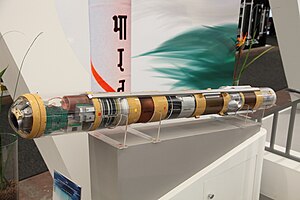HELINA MISSILE
The Nag missile also called "Prospina" for the land-attack version, is an Indian third-generation, all-weather, fire and forget lock on after launch anti tank guided missile (ATGM) with an operational range of 500 m to 20 km depending on variant. It has a single-shot hit probability of 90% and a ten-year, maintenance-free shelf life. The Nag has five variants under development: a land version, for a mast-mounted system; the helicopter-launched Nag (HELINA) also known as Dhruvastra. An air-launched version which will replace the current imaging infra red (IIR) to millimetric wave active rador homing seeker and the Nag Missile Carrier (NAMICA) "tank buster", which is a modified BMP-2 infantry fighting vehicle (IFV) produced under license in India by Ordnance Factory Medak (OFMK). Development of the Nag is part of the Integrated Guided Missile Development Program (IGMDP), run by Defence Research and Development Organization (DRDO). It is manufactured byBharat Dynamics Limited (BDL). India's Ministry of Defence announced on 19 July 2019 that the missile was ready for production. The Defence Research and Development Organization (DRDO) successfully completed the final trial of Nag anti-tank missile using a live warhead on a dud tank at Pokhran army ranges at 6.45 am on 21 Oct 2020.
DEVELOPMENT AND TESTING:
Helina has been developed by the Defence Research and Development Laboratory (DRDL), Hyderabad under the Missiles and Strategic Systems (MSS) cluster of the DRDO. Successful user trials of the missile have been conducted since 2018. Helinaor the helicopter-based Nag missile can strike targets up to 7km away. Development of the Nag missile began in 1988 under A.P.J.Abdul Kalam The first tests were conducted in November 1990. Development was delayed for several years because of issues with the IIR-based guidance system. The Nag missile underwent successful tests in September 1997 and January 2000. In 2000, MOD announced that the Nag was likely to enter full-scale production in early 2001. The Nag successfully completed its final validation trials and was expected to join the Indian Army's arsenal in 2011. Two missiles were launched simultaneously against a moving target, and another two missiles were launched against a stationary Vijavanta tank in quick succession, and all successfully hit the targets. The Indian Army was happy with the performance and expected to buy 443 missiles for Rs 335 crore.
The missile was tested successfully on 5 June 2017 at its maximum
range of 4 km (2.5 mi) in hot-desert conditions in a daytime trial at
the Chandan Field Firing Range near Jaisalmer Rajasthan, with a successful follow-up test taking place on 13 June
2017. DRDO shared that the trials which concluded were successful for
the extreme-heat daytime conditions of the desert. On 22 October 2020, India successfully carried out the final trial of
the Nag anti-tank guided missile from NAMICA, after which the weapon
system is now ready for induction into the Indian Army.
TECHNICAL CHARACTERISTIC:
The outside part of Nag missile is made of fibreglass. It is developed for engaging heavily covered tanks in all-weather conditions during day and night with a minimum range of 500 m and a maximum range of 4 km for the land variant. The third-generation fire-and-forget-class ATGM uses a imaging infrared (IIR) seeker that locks on to the target before launch. The airframe is made up of composite materials with high resistance to enemy countermeasures. The forward dome houses the guidance system. The middle portion of the body has sensor packages and the warhead. A booster rocket is located towards the rear end. The Nag consists of four foldable wings and four tail fins that stabilize it during flight. A real-time image processor located next to the guidance package helps enable automatic target detection and tracking capability. The digital autopilot helps in the guidance, stability, and control after launch. An electric actuation system also helps in flight control. The guidance system is based on an imaging infrared (IIR) seeker that ensures a high target accuracy in both top and front attack modes. A CCD camera integrated into the guidance system is useful as it is hard to jam. The initial guidance is provided by area association around the target, to which is added a centroid tracking mechanism. Homing in the terminal phase is done by area correlation around the centroid. The Nag rises upwards suddenly and then bends at a steep angle to aim for the target.
Varsha Tiwari.
Student.


Comments
Post a Comment